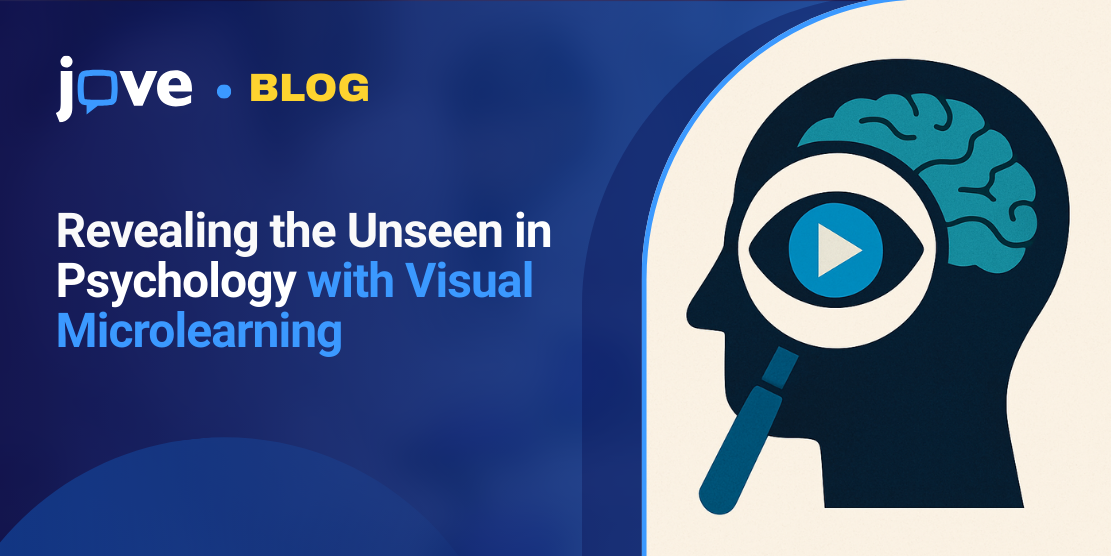Psychology is one of the most popular subjects in higher education, but it can also be one of the most challenging to teach. Many core concepts, like experimental design, cognitive processes, or developmental milestones, are complex or hidden from direct view.
For faculty, the challenge is clear: how do you hold attention, up engagement, and give students meaningful exposure to processes they may never be able to observe directly?
Visual microlearning offers a way forward. Short, focused videos give students visible anchors for theories or methods that might otherwise remain distant. Well-designed videos with interactive elements transform challenging content into engaging, active learning experiences that build lasting understanding.
Making Methods Manageable
Courses in experimental psychology are essential, but methods and statistics can feel like a barrier to first-year students. Short videos help reset attention and show methods in action, giving faculty a way to keep material tangible. Students can pause, review, and then return to discussion.
Beyond single videos, faculty can assign playlists of short methods demonstrations. Students watch at home, then arrive ready to compare designs or propose variations in class. This flips theory-heavy sections into more active, applied learning—an approach reflected in the recent webinar Microlearning Strategies for Experimental Psychology.
Correcting Misconceptions from Day One
Psychology carries a special challenge: students often arrive with strong ideas shaped by media, not evidence. Popular myths about personality tests, memory, or psychiatric disorders are familiar but misleading.
Microlearning can help set the record straight. By meeting misconceptions with evidence in short bursts, faculty can redirect attention toward real psychological principles.
For instance, students may assume they would never give in to peer pressure and that only “weak-willed” people conform. The video below shows otherwise: in the classic Asch line-judgement study, most participants went along with the group’s wrong answers.
When Real Exposure Isn’t Possible
Some of psychology’s most important insights cannot be recreated in class. Faculty cannot run a false memory experiment with children, or stage infant imitation studies, for ethical and logistical reasons. Even demonstrations of adult social behavior are constrained by time and context.
Research in teaching and learning shows that simulations effectively help fill this gap when live demonstrations are not feasible.1,2 Short videos provide that bridge: they show students the process, not just the theory, and make otherwise inaccessible research tangible.
This was a central theme in the webinar Pedagogy in Practice: Microlearning for Social & Developmental Psychology, which highlighted how short visual modules make abstract ideas accessible without the need for live demos.
Key Takeaways
Teaching psychology requires balancing theory, method, and lived human behavior—elements that do not always sit easily together. Microlearning through video is not a replacement for lectures or labs, but a way of making challenging material more manageable, engaging, and memorable. It works because it creates rhythm, offers exposure to studies students could not otherwise see, and ties assessment directly to the moment of learning.
By using microlearning, faculty can keep attention high, ground ideas in evidence, and open the door to more meaningful discussion. For students, that means concepts that not only make sense in class but also stay with them long after the lecture ends.
Request a JoVE playlist tailored to your syllabus and explore microlearning for your course.
- Morrison, B. W., Kelson, J., Morrison, N. M. V., & Bennett, G. (2025). You’re virtually a psychologist: enhancing professional psychology education through virtual client simulations. Australian Psychologist. 1–8. https://doi.org/10.1080/00050067.2025.2547800
- Imam Hossain, S., Kelson, J., & Morrison, B. (2024). The use of virtual patient simulations in psychology: A scoping review. Australasian Journal of Educational Technology, 40(6), 76-92. https://doi.org/10.14742/ajet.9559

